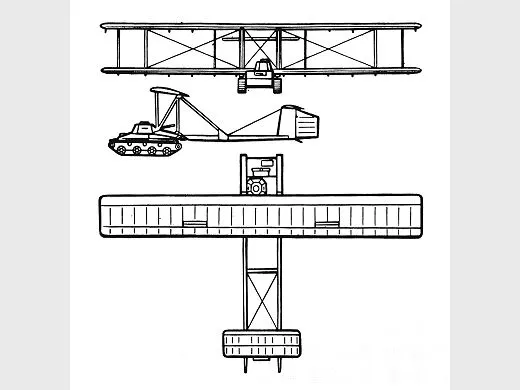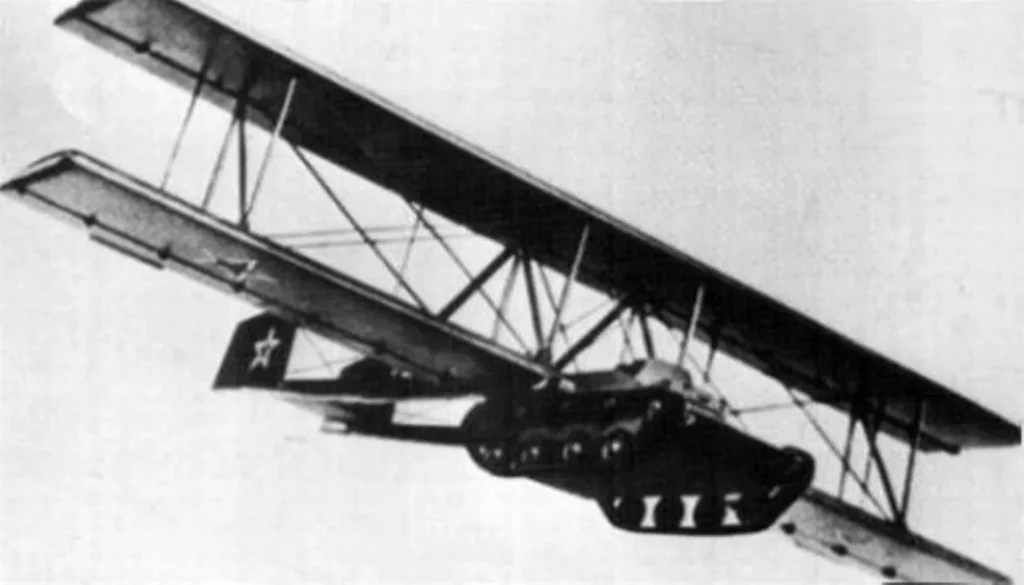The term “flying tank” typically refers to the A-10 Thunderbolt II, a heavily armored close-air support aircraft that acts similarly to a tank but can fly. But…
In the early 1940s, the Soviet Union was immersed in a difficult fight to thwart large Nazi German gains on Soviet territory. Partisan fighters (Soviet civilians who took up arms against the German invasion) required more powerful armament capable of inflicting significant damage on oncoming German columns of armor and soldiers, beyond what their small arms could provide. Oleg Antonov proposed a solution in the shape of a flying tank.

Tanks are not designed to fly under any circumstances. They are not aerodynamically suitable for flight, nor do they have wings or the necessary motors to generate lift to fly. Antonov’s solution was to strap a Krylya Tanka (Russian for “tank wings”) kit to a T-60 light tank, tow it into the air using a Pe-8 or TB-3 heavy bomber, and then release the flying tank near the drop zone, allowing the tank and its crew to glide to the battlefield while the tug aircraft sped away before German anti-aircraft gunners could target it.
The T-60 was chosen for the assignment due to its modest weight of 5.8 tonnes and the fact that companies were producing hundreds each day. The T-60’s weight was reduced further by removing its guns, ammunition, and head lamps, as well as reducing the quantity of fuel it carried. The Krylya Tanka kit would be strapped to the upper surfaces of the tank’s hull, with removable linkages connecting the control surfaces (i.e., rudders and flaps) to the driver inside the tank, allowing him to operate the T-60 flying tank once the tug aircraft released it.

The Krylya Tank kit itself consisted of two wings in a biplane layout (one over the other) with a span of almost 60 feet (or 18 meters), constructed of canvas and wood to decrease weight. Two tail booms connect to a twin-tail with movable rudders. The whole length was almost 40 feet (12 meters). Though the Soviet Air Force had initially ordered Antonov to construct a glider that could lift a tank rather than a tank that could fly, they were willing to give his proposal a try.
In the autumn months of 1942, Antonov and a team of mechanics and engineers finished the Krylya Tanka in less than three weeks and connected it to a modified T-60. The new designation for this unusual combat vehicle was A-40, sometimes also A-40T. Sergei Anokhin, a record-holding glider pilot and Soviet Air Force test pilot, flew the A-40 on the project’s first (and only) test flight. A TB-3 heavy bomber was assigned to the flight and was linked up to the A-40, which now weighed 7.8 tonnes due to the added weight of the Krylya Tanka kit.
After a lengthy takeoff run at Monino Airfield, the TB-3 tug and its A-40 were able to climb, but problems arose early in the form of overheating engines and rapidly decreasing airspeed in the TB3. The tug pilots understood that the A-40 (which had the aerodynamics of a cow) was putting a huge strain on their aircraft, and they needed to disconnect it soon or they’d fall out of the sky. They quickly released the wire, and Anokhin found himself flying a flying tank.
Somehow, the Krylya Tanka worked! Anokhin later reported that the A-40 glided significantly better than expected, proving that the concept of a flying tank was not so farfetched after all. Anokhin managed to land the tank in a nearby field, remove all the equipment, and drive back to Monino. However, the lack of an aircraft powerful enough to pull the 7.8 tonne A-40 at roughly 100 miles per hour to sustain lift rendered the A-40 unfeasible, and the Soviet Air Force ordered the project’s permanent closure.
Mandatory memes about the Flying Tank



